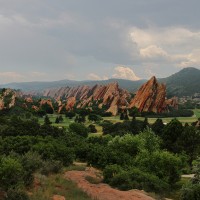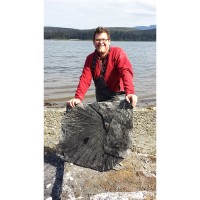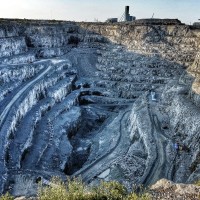Kirk Johnson, Rock Star
Kirk Johnson, director of the National Museum of Natural history, is the host of the new NOVA science series “Making North America” on PBS.

Kirk Johnson, the director of the National Museum of Natural History and the star of a new Nova series “Making North America.” (WGBH)
What is the director of the Smithsonian’s National Museum of Natural History doing, dangling over a cliff at the Grand Canyon from a rope?
Demonstrating in a most graphic way the stratification of the geological wonder. And sure enough, in one of the early segments of “Making North America,” a three-part special starting November 4 on the PBS science series “Nova,” the different shelves of the canyon slide out beneath him, courtesy of computer animation.
“The hope is that we get people excited about reading the planet,” Kirk Johnson says, safe in his fourth floor museum office. Since he was named Sant Director of the Smithsonian’s most popular museum in 2012, the boyish 55-year-old has popped up from time to time as an expert on a number of geology specials, including the Smithsonian Channel’s “Mass Extinction: Life at the Brink” and Discovery Channel’s upcoming “Racing Extinction.”
But for the three hour “Making North America,” Johnson is the face of the program, traveling to 17 states, Canada and the Bahamas for the flashy series, becoming for geology what Neil deGrasse Tyson is for astrophysics.
For the online part of the project, they’ve even made a Kirk Johnson bobblehead.
“I’ve been on lots of TV—about 25 or 30 shows. But usually it’s just spot talent,” Johnson says. “I’ve never presented before.”
And by presenting, that doesn’t just mean narrating after the fact or sitting behind his desk (though that would be pretty cool—the Washington Memorial is framed in a window just behind his right shoulder).
“It was a huge learning experience, put it that way,” Johnson says. “It was great fun. But I thought I had done TV and then I realize I hadn’t done TV before.” So he hung off that rope at the Grand Canyon. He went to a deep mine near Thunder Bay, Ontario, looking at 2.7 billion year-old-rocks. He traveled to Gooseberry Falls in northwest Minnesota to see its surface exposure of huge lava flows. He took them to “my main research area in southwestern North Dakota, where he’s found thousands of artifacts. But on the coast of Alaska, he says, “we made this amazing discovery of a fossilized palm frond in the winter tidal deposit right on camera.”
A lot of such films have shown geologists who appear to be discovering amazing things with the camera right there. But this, he promises, this actually happened that moment.
“I’m a purist,” he said a few weeks earlier, promoting the how at the TV Critics Association summer press tour. “We did a show with Nova a couple years ago in Snowmass Village where we had this discovery of mammoths and mastodons. They were saying, ‘Can you show us how you would find a mammoth bone?’ I said, ‘No, I absolutely will not do that. I will find one for you on camera.’
“If you know how to dig and you know where you’re digging, you will find stuff in a matter of minutes,” Johnson said. “So it’s way better for the thing to be real than a recreation. I abhor recreations.”
Indeed, one takeaway from “Making North America” is that anybody can find plant fossils or even dinosaurs anywhere in the country, if they just look.
“Dinosaurs were around for over 150 million years, and they’re in lots of rocks,” Johnson says. “And paleontologists have only been around for 150 years, and there’s not many of us. So the volume of rock that have dinosaurs versus the volume of paleontologists, it’s a huge ratio.”
Johnson says he was out in North Dakota just this summer and found 20 dinosaurs.
“If I go look for them, I will find them, because there’s tons of them out there,” he says. “It’s this sort of myth that they’re rare. It’s just that people don’t know how to look for them, and that, by the way, is pretty trivial too. It’s a pretty simple skill set.”
Instead of looking up as you walk around, you look down. “Look at the ground when you’re walking is what you do to find a dinosaur.”
And they’re everywhere—not just in faraway fields in the Dakotas. “We find dinosaurs in New Jersey and in New York,” Johnson says. “There’s a dinosaur from Washington, D.C. called Capitalsaurus, believe it or not. And there are dinosaurs in the L.A. Basin. There are fossils everywhere, and our continent has this very curious practice of burying its dead by the natural processes of sedimentation.
- Roxborough State Park near Denver, Colorado (WGBH)
- On the coast of Alaska, Johnson says, “we made this amazing discovery of a fossilized palm frond in the winter tidal deposit right on camera.” (WGBH)
- The Lac Des Iles Mine near Thunder Bay, Ontario (WGBH)
So if you know how to look, the stories are everywhere.
“And that’s what’s cool about the show,” he says. “Anybody who’s watching will be compelled to ask what’s happening beneath my feet? It doesn’t matter where you are, there’s a story there
Part of the reason is that the landscape has changed so much and continues to do so. The other point of “Making North America” is that the continent is still being made. “The landscape is always changing,” he says, “whether it’s by hurricanes, or the impacts of earthquakes, tornadoes or landslides, just simple erosion, or mountain-building processes.”
In fact, things are changing so much that his crew had to schedule a last minute filming trip to cover the hubbub over a summer New Yorker article predicting an imminent earthquake in the Pacific Northwest.
“It’s one of the few times when a geology story has had a huge impact on a bigger population,” Johnson says. “It really caught people of the Pacific Northwest by surprise. A show about the geology of North America that didn’t have it would be kind of remiss.”
Johnson knows the area: He became interested in geology when accompanying his father on rock climbs in the Pacific Northwest, where he grew up. “As a kid you need your little superpowers and mine was finding stuff—fossils or arrow heads or cool rocks and stuff,” he says. For a while that was enough.
“Then I thought: Wait a minute, these are all telling me something. There’s a story. Every one of these little things is a message from the past. Some little story is in there.”
He started going to the Burke Museum at the University of Washington and other museums that had fossils. “I’ve always been in this mode of finding stuff and taking them to museums and communicating the excitement of finding things,” he says.
Johnson studied geology at Amherst College, got a doctorate at Yale and before coming to the Smithsonian, was vice president and chief curator at the Denver Museum of Nature and Science.
Doing the show has been great, Johnson says, “because it helps me show my enthusiasm for this incredible planet we live on.”
The three-part series, “Nova: Making North America,” premiered November 4 at 9 p.m. and continues on November 11 and November 18 on PBS; check local listings.
This article by Roger Catlin was originally published by Smithsonian.com
Posted: 5 November 2015










